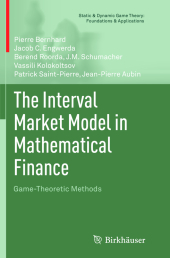 Neuerscheinungen 2015Stand: 2020-02-01 |
Schnellsuche
ISBN/Stichwort/Autor
|
Herderstra▀e 10
10625 Berlin
Tel.: 030 315 714 16
Fax 030 315 714 14
info@buchspektrum.de |

Pierre Bernhard, Jacob C. Engwerda, Berend Roorda
(Beteiligte)
The Interval Market Model in Mathematical Finance
2013. 2015. xvi, 348 S. 6 Tabellen. 235 mm
Verlag/Jahr: SPRINGER, BERLIN; SPRINGER NEW YORK 2015
ISBN: 1-489-98580-8 (1489985808)
Neue ISBN: 978-1-489-98580-4 (9781489985804)
Preis und Lieferzeit: Bitte klicken
Written by seven of the most prominent pioneers of the interval market model and game-theoretic approach to finance, this book provides a detailed account of several closely related modeling techniques for an array of problems in mathematical economics.
Toward the late 1990s, several research groups independently began developing new, related theories in mathematical finance. These theories did away with the standard stochastic geometric diffusion "Samuelson" market model (also known as the Black-Scholes model because it is used in that most famous theory), instead opting for models that allowed minimax approaches to complement or replace stochastic methods. Among the most fruitful models were those utilizing game-theoretic tools and the so-called interval market model. Over time, these models have slowly but steadily gained influence in the financial community, providing a useful alternative to classical methods.
A self-contained monograph, The Interval Market Model in Mathematical Finance: Game-Theoretic Methods assembles some of the most important results, old and new, in this area of research. Written by seven of the most prominent pioneers of the interval market model and game-theoretic finance, the work provides a detailed account of several closely related modeling techniques for an array of problems in mathematical economics. The book is divided into five parts, which successively address topics including:
˙ probability-free Black-Scholes theory;
˙ fair-price interval of an option;
˙ representation formulas and fast algorithms for option pricing;
˙ rainbow options;
˙ tychastic approach of mathematical finance based upon viability theory.
This book provides a welcome addition to the literature, complementing myriad titles on the market that take a classical approach to mathematical finance. It is a worthwhile resource for researchers in applied mathematics and quantitative finance, and has also been written in a manner accessible to financially-inclined readers with a limited technical background.
General introduction.-Part 1: Two classical problems revisited.- Merton┤s optimal dynamic portfolio revisited.- Probability free Black and Scholes theory.- Part 2: Robust control approach to option pricing.- Option pricing and the interval market model.- Vanilla options.- Digital options.- Validation: robustness and calibration.- Extensions.- Part 3: Tychastic approach to mathematical finance.- Some drawbacks of the stochastic approach.- Other mathematical models of uncertainty.- Example: cushion approach of asset-liability management of a portfolio.- Capture basin algorithm and application to option pricing.- Impulsive capture basin algorithm and applications to barrier options and the GARCH market model.- Part 4: Hedging in Interval Models.- Introduction: why hedging?.- The risk neutral valuation principle for options.- A numerical valuation procedure: the binomial tree model.- The fair price interval of an option.- Characterization of fair price intervals in terms of strategies and Martingale measures.-A case study: a comparison with the binomial tree model.- Some computational issues.- Part 5: Explicit Formulae for Rainbow Options and related topics.- Introduction: CRR and BS formulae via game theory.- Rainbow options depending on two or three underlying stocks.- Probabilistic interpretation.- Numerical algorithms.


